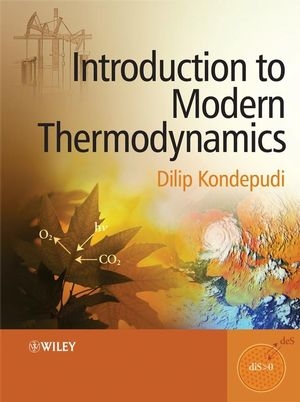
Introduction to Modern Thermodynamics
John Wiley & Sons Ltd (Verlag)
978-0-470-01598-8 (ISBN)
- Titel ist leider vergriffen;
keine Neuauflage - Artikel merken
Dilip Kondepudi is Thurman D. Kitchin Professor of Chemistry, Wake Forest University, where his main research interest is chiral asymmetry in nature. He has, in addition, many years teaching experience to both under- and postgraduate students. he is the author, with the late Ilya Prigogine, of the highly successful book Modern thermodynamics: From Heat engines to Dissipative Structures.
Preface. PART I THE FORMALISM OF MODERN THERMODYNAMICS. 1 BASIC CONCEPTS AND THE LAWS OF GASES. Introduction. 1.1 Thermodynamic Systems. 1.2 Equilibrium and Nonequilibrium Systems. 1.3 Biological and Other Open Systems. 1.4 Temperature, Heat and Quantitative Laws of Gases. 1.5 States of Matter and the van der Waals Equation. 1.6 An Introduction to Kinetic Theory of Gases. Appendix 1.1 Partial Derivatives. Appendix 1.2 Elementary Concepts in Probability Theory. Appendix 1.3 Mathematica Code. References. Examples. Exercises. 2 THE FIRST LAW OF THERMODYNAMICS. The Idea of Energy Conservation amidst New Discoveries. 2.1 The Nature of Heat. 2.2 The First Law of Thermodynamics: The Conservation of Energy. 2.3 Elementary Applications of the First Law. 2.4 Thermochemistry: Conservation of Energy in Chemical Reactions. 2.5 Extent of Reaction: A State Variable for Chemical Systems. 2.6 Conservation of Energy in Nuclear Reactions and Some General Remarks. 2.7 Energy Flows and Organized States. Appendix 2.1 Mathematica Codes. References. Examples. Exercises. 3 THE SECOND LAW OF THERMODYNAMICS AND THE ARROW OF TIME. 3.1 The Birth of the Second Law. 3.2 The Absolute Scale of Temperature. 3.3 The Second Law and the Concept of Entropy. 3.4 Entropy, Reversible and Irreversible Processes. 3.5 Examples of Entropy Changes due to Irreversible Processes. 3.6 Entropy Changes Associated with Phase Transformations. 3.7 Entropy of an Ideal Gas. 3.8 Remarks about the Second Law and Irreversible Processes. Appendix 3.1 The Hurricane as a Heat Engine. Appendix 3.2 Entropy Production in Continuous Systems. References. Examples. Exercises. 4 ENTROPY IN THE REALM OF CHEMICAL REACTIONS. 4.1 Chemical Potential and Affi nity: The Thermodynamic Force for Chemical Reactions. 4.2 General Properties of Affinity. 4.3 Entropy Production Due to Diffusion. 4.4 General Properties of Entropy. Appendix 4.1 Thermodynamics Description of Diffusion. References. Examples. Exercises. 5 EXTREMUM PRINCIPLES AND GENERAL THERMODYNAMIC RELATIONS. Extremum Principles in Nature. 5.1 Extremum Principles Associated with the Second Law. 5.2 General Thermodynamic Relations. 5.3 Gibbs Energy of Formation and Chemical Potential. 5.4 Maxwell Relations. 5.5 Extensivity with Respect to N and Partial Molar Quantities. 5.6 Surface Tension. References. Examples. Exercises. PART II APPLICATIONS: EQUILIBRIUM AND NONEQUILIBRIUM SYSTEMS. 6 BASIC THERMODYNAMICS OF GASES, LIQUIDS AND SOLIDS. Introduction. 6.1 Thermodynamics of Ideal Gases. 6.2 Thermodynamics of Real Gases. 6.3 Thermodynamics Quantities for Pure Liquids and Solids. Appendix 6.1 Equations of State. Reference Examples. Exercises. 7 THERMODYNAMICS OF PHASE CHANGE. Introduction. 7.1 Phase Equilibrium and Phase Diagrams. 7.2 The Gibbs Phase Rule and Duhem's Theorem. 7.3 Binary and Ternary Systems. 7.4 Maxwell's Construction and the Lever Rule. 7.5 Phase Transitions. References. Examples. Exercises. 8 THERMODYNAMICS OF SOLUTIONS. 8.1 Ideal and Nonideal Solutions. 8.2 Colligative Properties. 8.3 Solubility Equilibrium. 8.4 Thermodynamic Mixing and Excess Functions. 8.5 Azeotropy. References. Examples. Exercises. 9 THERMODYNAMICS OF CHEMICAL TRANSFORMATIONS. 9.1 Transformations of Matter. 9.2 Chemical Reaction Rates. 9.3 Chemical Equilibrium and the Law of Mass Action. 9.4 The Principle of Detailed Balance. 9.5 Entropy Production due to Chemical Reactions. 9.6 Elementary Theory of Chemical Reaction Rates. 9.7 Coupled Reactions and Flow Reactors. Appendix 9.1 Mathematica Codes. References. Examples. Exercises. 10 FIELDS AND INTERNAL DEGREES OF FREEDOM. The Many Faces of Chemical Potential. 10.1 Chemical Potential in a Field. 10.2 Membranes and Electrochemical Cells. 10.3 Isothermal Diffusion. Reference. Examples. Exercises. 11 INTRODUCTION TO NONEQUILIBRIUM SYSTEMS. Introduction. 11.1 Local Equilibrium. 11.2 Local Entropy Production, Thermodynamic Forces and Flows. 11.3 Linear Phenomenological Laws and Onsager Reciprocal Relations. 11.4 Symmetry-Breaking Transitions and Dissipative Structures. 11.5 Chemical Oscillations. Appendix 11.1 Mathematica Codes. References. Further Reading. Exercises. PART III ADDITIONAL TOPICS. 12 THERMODYNAMICS OF RADIATION. Introduction. 12.1 Energy Density and Intensity of Thermal Radiation. 12.2 The Equation of State. 12.3 Entropy and Adiabatic Processes. 12.4 Wien's Theorem. 12.5 Chemical Potential of Thermal Radiation. 12.6 Matter-Antimatter in Equilibrium with Thermal Radiation: The State of Zero Chemical Potential. References. Examples. Exercises. 13 BIOLOGICAL SYSTEMS. 13.1 The Nonequilibrium Nature of Life. 13.2 Gibbs Energy Change in Chemical Transformations. 13.3 Gibbs Energy Flow in Biological Systems. 13.4 Biochemical Kinetics. References. Further Reading. Examples. Exercises. 14 THERMODYNAMICS OF SMALL SYSTEMS. Introduction. 14.1 Chemical Potential of Small Systems. 14.2 Size-Dependent Properties. 14.3 Nucleation. 14.4 Fluctuations and Stability. References. Examples. Exercises. 15 CLASSICAL STABILITY THEORY. 15.1 Stability of Equilibrium States. 15.2 Thermal Stability. 15.3 Mechanical Stability. 15.4 Stability with Respect to Fluctuations in N. References. Exercises. 16 CRITICAL PHENOMENA AND CONFIGURATIONAL HEAT CAPACITY. Introduction. 16.1 Stability and Critical Phenomena. 16.2 Stability and Critical Phenomena in Binary Solutions. 16.3 Configurational Heat Capacity. Further Reading. Exercises. 17 ELEMENTS OF STATISTICAL THERMODYNAMICS. Introduction. 17.1 Fundamentals and Overview. 17.2 Partition Function Factorization. 17.3 The Boltzmann Probability Distribution and Average Values. 17.4 Microstates, Entropy and the Canonical Ensemble. 17.5 Canonical Partition Function and Thermodynamic Quantities. 17.6 Calculating Partition Functions. 17.7 Equilibrium Constants. Appendix 17.1 Approximations and Integrals. Reference. Examples. Exercises. LIST OF VARIABLES. STANDARD THERMODYNAMIC PROPERTIES. PHYSICAL CONSTANTS AND DATA. NAME INDEX. SUBJECT INDEX.
| Erscheint lt. Verlag | 8.4.2008 |
|---|---|
| Verlagsort | Chichester |
| Sprache | englisch |
| Maße | 195 x 252 mm |
| Gewicht | 1088 g |
| Themenwelt | Naturwissenschaften ► Chemie ► Physikalische Chemie |
| Naturwissenschaften ► Physik / Astronomie ► Thermodynamik | |
| ISBN-10 | 0-470-01598-5 / 0470015985 |
| ISBN-13 | 978-0-470-01598-8 / 9780470015988 |
| Zustand | Neuware |
| Haben Sie eine Frage zum Produkt? |
aus dem Bereich


